Django——模板標籤 模板的繼承與引用
阿新 • • 發佈:2018-12-22
Django
- 標籤在渲染的過程中提供任意的邏輯
- 標籤語法: 由%}和 {% 來定義的,例如:{%tag%} {%endtag%}
- 這個定義是刻意模糊的。 例如,一個標籤可以輸出內容,作為控制結構,例如“if”語句或“for”迴圈從資料庫中提取內容,甚至可以訪問其他的模板標籤。
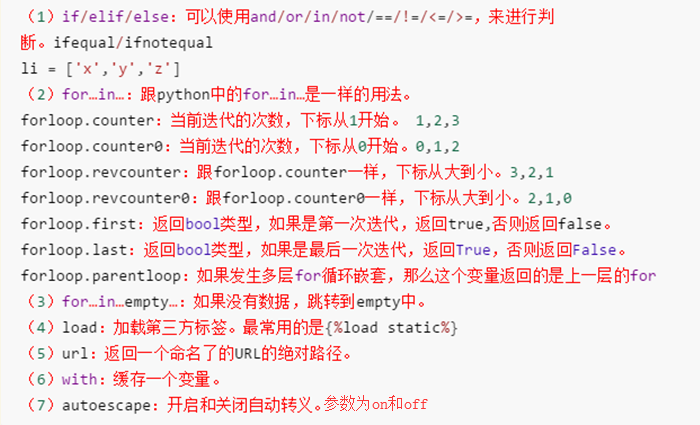
配置好url和檢視
views.py
# 模板標籤 def tem_tags(request):return render(request, 'book/tags.html', context={ 'str1': 'Django', 'str2': 'Flask', 'fruit_list': ['apple', 'pear', 'orange'], 'num_list': ['one', 'two', 'three'], "whats_your_name": 'whoaU?', 'html': '<h1>hello world</h1>' })
<!DOCTYPE html> <html lang="en"> <head> <meta charset="UTF-8"> <title>模板標籤</title> <style> </style> </head> <body> <p></p> if elif else {% if str1 == 'tornado' %} 這是tornado課程 {% elif str1 == str2 %} 這是scrapy課程 {% else %} 這是{{ str1 }}課程 {% endif %}<br> ifnotequal ifequal {% ifnotequal str1 str2 %} {{ str1 }}{{ str2}}是兩個不同的課程 {% endifnotequal %} <br> {% for foo in fruit_list %} {{ foo }}<br> {% endfor %} <br> forloop.counter0 {% for foo in fruit_list %} {{ forloop.counter }} {% if forloop.counter0 == 1 %} {{ foo }}是梨子 <br> {% elif forloop.counter0 == 0 %} {{ foo }}是蘋果 <br> {% else %} {{ foo }}是橘子 {% endif %} {% endfor %} <br> first last {% for foo in fruit_list %} {% if forloop.first %} first is {{ foo }} <br> {% endif %} {% if forloop.last %} last is {{ foo }} <br> {% endif %} {% endfor %} <br> forloop.parentloop. {% for foo in num_list %} {% for fo in fruit_list %} {% if forloop.parentloop.counter0 == 1 %} {{ foo }} better {{ fo }} <br> {% else %} {{ foo }} {{ fo }} <br> {% endif %} {% endfor %} {% endfor %} <br> url <a href="{% url 'static' %}">跳轉到靜態檔案演示頁面(引數後面用空格隔開)</a> <br> with {% with whats_your_name as o %} {{ o }}<br> {% endwith %} <br> autoescape {% autoescape on %} {{ html }} {% endautoescape %} <br> {% autoescape off %} {{ html }} {% endautoescape %} </body>
頁面結果:

- Django模版引擎中最強大也是最複雜的部分就是模版繼承了。 模版繼承可以讓你建立一個基本的“骨架”模版,它包含您站點中的全部元素,並且可以定義能夠被子模版覆蓋的 blocks 。
- 模板繼承使用extends標籤實現。通過使用block來給子模板開放介面。
- 1、extends必須是模板中的第一個出現的標籤。
- 2、子模板中的所有內容,必須出現在父模板定義好的block中,否則django將不會渲染。
- 3、如果出現重複程式碼,就應該考慮使用模板。
- 4、儘可能多的定義block,方便子模板實現更細的需求。
- 5、如果在某個block中,要使用父模板的內容,使用block.super獲取。
在模板資料夾中新建兩個html檔案

base.html檔案中:
<!DOCTYPE html> <html lang="en"> <head> <meta charset="UTF-8"> <title>{% block title %}base{% endblock %}</title> <style> </style> </head> <body> {% block content %} <p>這是基類模板檔案</p> {% endblock %} {% block last %} <p>這是結尾的模板內容</p> {% endblock %} </body> </html>
index_1.html檔案中:
{% extends 'inheritance_reference/base.html' %}
然後配置到url和view檢視將index_1渲染出來:
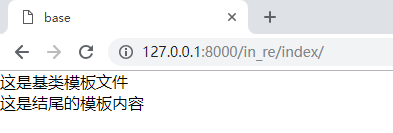
現在我們來更改block裡面的內容,做成我們自己的東西,將index_1.py中對應名字的block內容進行更改
{% extends 'inheritance_reference/base.html' %} {% block title %} 我自己的網頁 {% endblock %} {% block content %} <p>這是我自己的中心內容,不是繼承來的</p> {% endblock %} {% block last %} <p>這是我自己的結尾內容,不是繼承來的</p> {% endblock %}
再渲染出來檢視
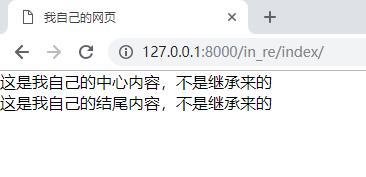
接下來我們來繼承父類base中的內容,並加上我們自己的內容
{% extends 'inheritance_reference/base.html' %} {% block title %} 我自己的網頁 {% endblock %} {% block content %} {{ block.super }} <p>這是我自己的中心內容,不是繼承來的</p> {% endblock %} {% block last %} {{ block.super }} <p>這是我自己的結尾內容,不是繼承來的</p> {% endblock %}
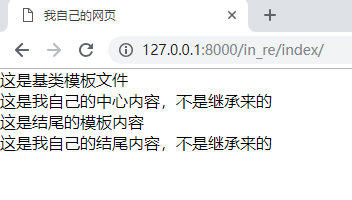
現在再base中的block外面新增一句話,在index_1中也新增一句話
base.py
<!DOCTYPE html> <html lang="en"> <head> <meta charset="UTF-8"> <title>{% block title %}base{% endblock %}</title> <style> </style> </head> <body> {% block content %} <p>這是基類模板檔案</p> {% endblock %} {% block last %} <p>這是結尾的模板內容</p> {% endblock %} <p>這是base沒有block包括的內容</p> </body> </html>
index_1.py中:
{% extends 'inheritance_reference/base.html' %} {% block title %} 我自己的網頁 {% endblock %} {% block content %} {{ block.super }} <p>這是我自己的中心內容,不是繼承來的</p> {% endblock %} {% block last %} {{ block.super }} <p>這是我自己的結尾內容,不是繼承來的</p> {% endblock %} <p>這是index_1中沒有block包括的內容</p>
檢視結果:
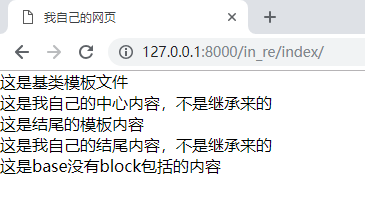
子模板中的所有內容,必須出現在父模板定義好的block中,否則django將不會渲染。
